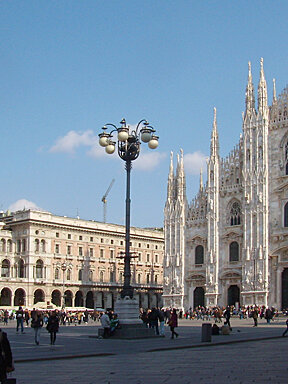
© Castello Sforzesco

© Castello Sforzesco

© Castello Sforzesco
Castello Sforzesco (Sforzesco Castle), Northwest Milan
Renaissance castle in the centre of Milan with stunning art and museums
The Castello Sforzesco is Milan's main attraction after the Duomo. The castle's popularity is due in no small part to the dozen museums and archives within its grounds, with exhibitions on subjects as diverse as Palaeolithic history to 1950s furniture.
The castle was home to the noble Visconti family from 1368. It served as a fortress on the medieval wall with barracks and a moat. The castle was the Visconti's largest residence, with 180 metres in length, four fortified towers and a defensive wall.
The last Visconti dweller died with no heirs, and his legitimised bastard daughter was married to the military leader Francesco Sforza, an astute politician who became ruler of Milan in 1450. He built additions on the castle designed by Tuscan architect Filarete, who worked alongside military engineers.
His successor Galeazzo Maria Sforza completed the castle with a courtyard, frescoes in the rooms and a Ducal chapel. After his murder, his brother Ludovico il Moro took the power, transforming the Milanese court into one of the most refined of the time with artists such as Bramante or da Vinci. Frescoes painted by Leonardo in the Sala delle Asse still survive.
During the Spanish domination in the 1500s, an enormous star-shaped fortification was built around the castle. With up to 3,000 men protecting its walls, it was one of the biggest citadels in Europe. The star-shaped bulwarks were later knocked down under the Napoleonic reign. It was later restored in the late 19th century, when the Filarete tower was reimagined.
This long history of destruction and rebuilding has changed the image of the castle over the centuries, with the most recent work of restoration of the damage caused during World War II taken on by the acclaimed BBPR architectural partnership.
You can now admire the castle's defences on the outside, including remains of the ravelins, the 'ghirlanda' or outer wall with its defensive towers and a covered road underneath, as well as the moats. Inside, entering from Filarete Tower, the castle is dominated by the Courtyard of Arms, extensively restored in the 19th century, with the Spanish Hospital on one side. The Ducal Courtyard, on the other hand, was the centre of the dukes' residence and shows remains of the 15th-century building.
The Ducal apartments house the different museums of the castle, featuring Renaissance frescoes and other works of art and historical objects. Around the castle, there is an extensive park which has also been changed throughout the centuries.
Watch out for
The most recognisable feature of the Castello Sforzesco is the Filarete Tower, which has become a symbol of Milan. Tuscan architect Antonio Averulino, known as Filarete, designed it in 1452. It was destroyed in 1521, so the current tower is the result of the late 19th-century restoration, inaugurated in 1905.
Visitor comments
- "It's a beautiful castle in the city center, free visiting and just costs 5€ to visit all the museums inside, perfect for family or anyone who has no plan on the day." - Trip Advisor
- "By chance I walked to the Castello Sforzesco and was pleasantly surprised at the experience. The Castello is quite impressive and the museum is an added attraction. Well worth a visit." - Trip Advisor
- "It was like a movie for us, a castle with big walls and special gates! Nice yards and great history behind." - Trip Advisor
When to come
The castle grounds are open every day from 07:00 to 19:00. The museums open from 09:00 to 17:30 Tuesday to Sunday.
How to get passes
Admission to the castle grounds is free. Entry to the museums costs 5€.














